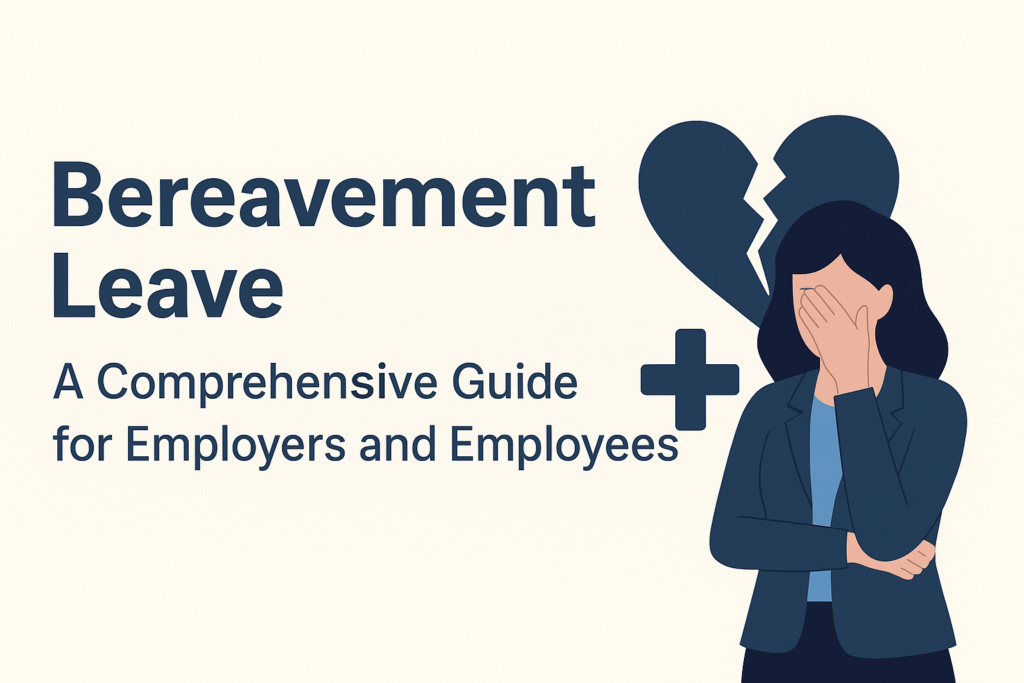Grief is a deeply personal and often overwhelming experience, yet it is also something that touches everyone at some point in life. When an employee loses a loved one, the impact extends far beyond their personal world—it can affect their emotional well-being, focus, and ability to perform at work. In these moments, having the security of bereavement leave can make all the difference.
Bereavement leave is more than just time away from the office—it is a compassionate acknowledgment that employees are human beings first, with lives, families, and responsibilities outside of work. While not always mandated by law, many employers recognize its importance as a way to support their teams, foster loyalty, and create a culture of empathy.
In this guide, we’ll cover everything you need to know about bereavement leave: what it is, how it differs from compassionate leave, which states require it, who is eligible, and how businesses can craft policies that balance compassion with practicality. Whether you’re an employee seeking clarity or an employer building supportive workplace policies, this comprehensive overview will help you navigate bereavement leave with understanding and care.
What Is Bereavement Leave?
Bereavement leave is the time an employer grants to an employee following the death of a loved one. It provides space to process grief, attend funeral or memorial services, and take care of legal and personal matters such as handling estates, organizing ceremonies, and supporting surviving family members.
Unlike vacation or sick leave, bereavement leave is not a time for rest or recovery from illness—it is specifically intended for coping with the emotional, logistical, and practical realities of loss. For many employees, this leave represents an important gesture of compassion from their employer, signaling that their humanity is recognized in the workplace.
Is Bereavement the Same Thing as Compassionate Leave?
Bereavement leave and compassionate leave are often confused but have slightly different meanings.
- Bereavement leave is specifically tied to the death of a loved one.
- Compassionate leave is broader and may also cover other family emergencies such as caring for a seriously ill relative, supporting a partner during a medical crisis, or dealing with traumatic events.
Some employers combine both under one policy, while others separate them. In either case, the goal is the same: to provide employees with the time and space needed to care for themselves and their families during moments of hardship.
Is Bereavement Leave Mandatory?
There is no federal law in the United States requiring employers to provide bereavement leave. Unlike other types of protected leave, such as medical leave under the Family and Medical Leave Act (FMLA), bereavement leave is optional at the federal level.
However, several states have passed their own laws mandating bereavement leave in certain circumstances. Outside of these states, it is up to individual companies to decide whether to offer bereavement leave. Many organizations choose to provide it as part of a supportive workplace culture, even if not legally required.
Which States Require Bereavement Leave?
- California – Employers with five or more employees must provide up to five days of unpaid bereavement leave for the death of a close family member. Employees may choose to use accrued vacation, sick leave, or PTO during this time if they wish to be paid.
- Illinois – Under the Family Bereavement Leave Act, employees of companies with 50 or more workers may take up to 10 days of unpaid leave. The law covers not only family deaths but also pregnancy loss, failed adoptions, unsuccessful fertility procedures, and stillbirth.
- Maryland – Employers who already provide paid leave must allow employees to use it for bereavement purposes in the event of the death of a spouse, parent, or child.
- Washington – The state’s Paid Family and Medical Leave program allows employees up to seven days of paid bereavement leave after the death of a child.
- Oregon – The Oregon Family Leave Act grants eligible employees up to two weeks of unpaid leave per family member’s death, capped at 12 weeks per year.
- Vermont, Massachusetts, and New Jersey – These states have passed or are advancing legislation around bereavement leave. In some cases, protections are tied to family leave acts, union agreements, or specific employment categories.
Employers operating across multiple states should review state-specific requirements to remain compliant and avoid legal risks.
Who Can Take Bereavement Leave?
Eligibility depends on the law in the state or the company’s internal policy. Most employers extend bereavement leave to immediate family, which generally includes:
- Spouse or domestic partner
- Children (biological, adopted, foster, or stepchildren)
- Parents and stepparents
- Siblings
- Grandparents and grandchildren
Progressive organizations may broaden eligibility to include:
- In-laws and extended relatives
- Close friends, roommates, or chosen family
- Pregnancy or infant loss
- Pets, recognizing the deep emotional bond many employees share with them
By expanding eligibility, companies send a strong message of inclusivity and understanding.
Is Proof Required to Take Bereavement Leave?
Some employers request proof of loss, such as an obituary, funeral program, or death certificate. This is usually for payroll purposes or to prevent misuse of leave.
However, requiring documentation can feel intrusive to grieving employees. Best practice is to only request proof in rare situations or to accept less formal evidence, such as a program from a memorial service. Empathy and trust should guide the process.
How Long Is Bereavement Leave?
The length of bereavement leave varies:
- Typical company policies: 3 to 5 days for immediate family, 1 to 2 days for extended relatives.
- State laws: Range from 5 days (California) to 10 days (Illinois) to multiple weeks (Oregon).
- Progressive practices: Some employers allow extended leave for international travel, multiple losses in a short period, or personal circumstances.
Surveys show that most employers provide five days of leave for immediate family and three days for extended family. Some also grant specific allowances for pregnancy loss or stillbirth.
Is Bereavement Leave Paid or Unpaid?
This depends entirely on the employer and state laws:
- Paid leave – Many employers choose to offer bereavement leave as paid time off, signaling support and reducing stress for grieving employees.
- Unpaid leave – Some state laws mandate bereavement leave but allow it to be unpaid. Employees may use existing PTO or sick leave balances if they wish.
- Hybrid approach – Companies may offer a certain number of paid days with additional unpaid leave available upon request.
Providing paid bereavement leave is increasingly seen as a best practice, especially in organizations prioritizing employee well-being.
Why Your Business Should Provide Bereavement Leave
Even when not legally required, offering bereavement leave benefits both employees and employers.
- Supports mental health: Time off helps employees process grief, reducing long-term stress and burnout.
- Builds trust and loyalty: Compassionate policies foster stronger employee commitment.
- Improves productivity: Employees who are rushed back to work often perform poorly. A brief leave allows them to return more focused and resilient.
- Strengthens company culture: Compassionate policies demonstrate that the organization values people as much as performance.
Bereavement Policy Advice for Business Owners
Create a Comprehensive Policy
Outline who is eligible, how much time is granted, whether it is paid or unpaid, and the process for requesting leave. Clarity prevents confusion during emotionally charged moments.
Make the Policy Inclusive
Recognize that grief comes in many forms—loss of a child, miscarriage, a close friend, or even a beloved pet. Inclusive policies show employees they are valued beyond traditional definitions of family.
Allow for Flexibility
Consider allowing intermittent leave, rolling leave (e.g., any time within 90 days of the death), or extended options for travel and cultural traditions.
Keep Policies Updated in the Employee Handbook
Include bereavement leave in your handbook, ensure managers understand it, and regularly update policies to reflect new laws and workplace norms.
How to Support a Grieving Employee
Bereavement leave is only one piece of the puzzle. Supporting employees requires ongoing compassion:
- Offer Employee Assistance Programs (EAPs) and counseling.
- Allow flexible or reduced schedules when employees return.
- Check in privately to ask how they’re doing.
- Encourage coworkers to be patient and respectful.
- Reassign tasks temporarily if needed to reduce stress.
A caring workplace not only helps employees heal but also builds a stronger, more cohesive team.
What to Include in a Bereavement Leave Policy
A strong policy should cover:
- Eligible family members and relationships
- Duration of leave (and whether it varies by relationship)
- Paid vs. unpaid status
- Documentation requirements, if any
- How leave requests should be submitted
- Whether leave can be intermittent or extended
- Support resources available to employees
Can You Take Bereavement Leave Before Someone Dies?
Typically, bereavement leave begins after a death occurs. However, employers may allow compassionate leave for situations such as end-of-life caregiving, hospice visits, or preparing for a funeral in advance. Policies should clearly state whether pre-loss leave is allowed.
Can Bereavement Leave Be Denied?
In states where it is legally mandated, eligible employees cannot be denied bereavement leave. In other states, employers may technically deny requests if no policy exists. However, doing so risks damaging employee morale and harming the organization’s reputation.
Most forward-thinking businesses understand that allowing bereavement leave is not just a policy—it’s a reflection of organizational values.
Frequently Asked Questions About Bereavement Leave
1. Is bereavement leave covered under FMLA?
No. The Family and Medical Leave Act (FMLA) does not require employers to provide bereavement leave. FMLA is specifically for serious health conditions of the employee or their family members, or for bonding with a new child. However, if an employee develops a serious health condition due to grief (such as depression or anxiety requiring medical care), FMLA could apply indirectly.
2. How many days is typical for bereavement leave?
Most employers provide between three to five days for the death of an immediate family member. Some employers may offer one or two days for extended relatives, and a few allow longer leave for special circumstances such as pregnancy loss or international travel to attend a funeral.
3. Do I get paid during bereavement leave?
That depends on the employer. Some companies provide bereavement leave as paid time off, while others designate it as unpaid but allow employees to use accrued vacation or sick days. State laws that mandate bereavement leave generally require only unpaid time, leaving the decision about pay up to the employer.
4. Can an employer deny bereavement leave?
In states with mandated bereavement laws, employers cannot deny leave to eligible employees. In states without such laws, an employer may technically deny a request if there is no company policy. However, doing so can harm morale, productivity, and the company’s reputation. Many organizations prefer to offer at least some form of leave to show compassion.
5. Can I take bereavement leave for a miscarriage or pregnancy loss?
Yes, in some states like Illinois, pregnancy and fertility-related losses are explicitly covered under bereavement leave laws. Even where not required by law, many progressive employers voluntarily include miscarriage, stillbirth, or failed adoption in their bereavement policies to support grieving employees.
6. Can I use bereavement leave for non-family members?
Traditional policies usually restrict leave to immediate family members. However, many modern companies have expanded definitions of “family” to include domestic partners, in-laws, close friends, or even pets. Since grief is not limited to traditional family structures, more employers are moving toward inclusive policies.
7. What if multiple family members pass away in the same year?
Policies vary, but most employers allow separate bereavement leave for each qualifying death. State laws that set yearly caps (such as Oregon’s 12-week maximum) may limit the total amount of leave available, so employees should check both state law and company policy.
8. Can bereavement leave be taken intermittently?
Some policies allow bereavement leave to be split into separate days rather than taken all at once. For example, an employee may attend the funeral immediately but reserve additional days for estate matters or memorial services later. If intermittent use is important, employees should confirm with HR.
9. Do all companies offer bereavement leave?
No. While many employers recognize the importance of supporting grieving employees, not all provide formal bereavement leave policies. In such cases, employees may need to use vacation, sick leave, or unpaid time off.
10. What should be included in a bereavement leave policy?
A strong policy should clearly define:
- Which relationships qualify
- How many days are allowed
- Whether the leave is paid or unpaid
- Any documentation requirements
- Options for intermittent or extended leave
- Whether pregnancy loss or close non-family relationships are included







